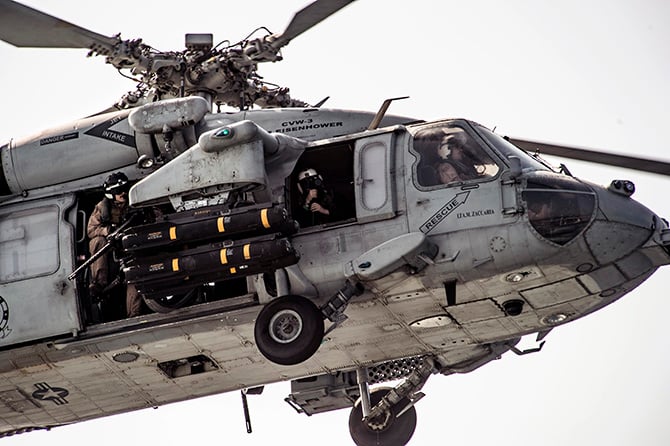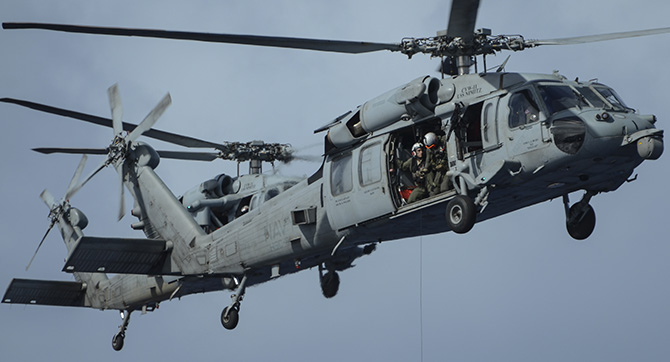
Thousands of hours are flown by helicopters each year to provide plane guard search-and-rescue airborne alert for fixed-wing flight operations. These same helicopters could be flying as a defensive air patrol, prepared to defend our surface ships against the full range of emerging maritime threats.

The helicopter sea combat (HSC) community can do much more than plane guard and logistics. Surface warfare, personnel recovery, and maritime interception operations—missions firmly entrenched as core competencies of the HSC community—should be given greater priority.
Plane guard tasking always has been about managing risk to our force, and we must be responsive to the way risks change over time. When Navy helicopters first started replacing ships as the primary plane guard assets, the naval aviation mishap rate was more than 50 Class A mishaps per 100,000 flight hours. Safety innovations across the naval aviation enterprise have brought the total aircraft destroyed down from 776 in 1954 to 13 in 2014. With the Class A mishap rate well below five per 100,000 flight hours, it is time to look at the sources of new threats or increasing risk to our forces.
Threats to our surface assets are growing and evolving with time. Recent history shows that both state and non-state actors are escalating their asymmetric capabilities. Threats to U.S. vessels also include antiship missiles, launched from shore or from ship. Small and less observable vessels are being equipped with more advanced antiship missiles, with larger navies selling this technology to other countries’ armed forces, increasing weapon systems proliferation around the world and accelerating risk to our forces.

Piracy concerns are returning, threatening U.S. warships and interests, and the Navy must be prepared to act on national threats at any time while deployed. Smaller, asymmetrical forces, as well as larger, more conventional forces, are increasing the use of unmanned systems, and the United States must continue to advance its ability to counter them.
If U.S. forces are willing to keep helicopters flying thousands of hours per year to be ready to rescue fixed-wing aviators who are at a historically low (and ever decreasing) risk of having a mishap near the ship, how do we explain to our sailors that we will not expend that same effort to protect them? This is especially hard to justify when the risk to our sailors from a broad range of threats is increasing and the ability to serve both search-and-rescue and defensive roles is possible.
Squadrons and strike groups have started to recognize this shift in risk and are modifying their plane guard operations. Unfortunately, they face significant constraints because, despite the MH-60S being designed as a multimission platform, it is poorly designed to move quickly between missions or perform more than one at once. This was well documented in the MH-60S Block 3 Initial Operational Test and Evaluation Final Report from October 2007, but little has been done to improve the MH-60S’s mission flexibility or rapid reconfiguration capability.
The primary constraint is the inability to configure the aircraft in a truly search-and-rescue-capable manner while also carrying destructive-fire weapons. The current mounts for the .50 caliber crew-served weapon, the GAU-21, sit in the cabin door opening. This restricts cabin use, limits access to the rescue hoist, and prevents the installation of the second auxiliary fuel tank. High-explosive ordnance currently is carried on the external weapon system, which obstructs cabin door access, restricts crew-served weapon fields-of-fire, and imposes heavy weight penalties.
The standard plane guard weapons configuration has been to carry two M-240D 7.62-mm. crew-served weapons. Unfortunately, the 7.62-mm. round combined with the rate of fire of an M-240D has little effect on the types of threats that are of primary concern. Ideally, the aircraft would not have the external weapon system installed for plane guard, but frequently maintenance cannot or will not remove it, leaving the aircraft in the least capable configuration.
There is a solution available to provide a fully armed helicopter on every plane guard flight. This solution is already in the Department of Defense inventory, and has been proven in combat. The external gun mount system, in use on Air Force and Army H-60 aircraft, allows for mounting the GAU-21 along with Hellfires and 2.75-inch rockets at the gunner’s window. This gives unfettered access to the cabin, cabin doors, and rescue hoist. The mounts also can integrate an additional expendables dispenser on each side, which doubles the defensive stores on board, significantly improving aircraft combat survivability.
When combined with Hellfire or rockets, the external gun mount system allows for an 81-degree greater field of fire over the existing configuration. The system allows the crew-served weapons to be fixed forward, allowing use of existing strafe tactics, with the added capability to rapidly shift back into crew-served employment, preserving full field of fire. It enables use of the second auxiliary fuel tank, increasing time on station 40 percent over current up-gunned configurations. This makes it possible to cover any standard launch-and-recovery cycle while up-gunned, even in conditions up to 50 degrees Celsius, which is not currently achievable.
Implementing this proven solution would allow thousands of hours of plane guard flown every year to be converted directly into critically needed defensive air patrol, providing truly destructive-fires-capable aircraft ready to defend strike groups and amphibious task forces from manned and unmanned threats on the surface and in the air. This can be done without sacrificing any search-and-rescue capability. In fact, this configuration would greatly increase the ability to effect a rescue in a contested environment.
This solution can be quickly implemented. The approach uses the Hellfire missile variants, 2.75-inch unguided rockets, and the advanced precision-kill weapon system already in the fleet. As a result, the cost is minimized compared to the capabilities gained. This would give the MH-60S the same offensive and defensive loadout as a UH-1Y employed by the Marine Corps. It would also put naval helicopters to work guarding the entire strike group or amphibious task force and the aviators. No strike group or amphibious task force commander should be forced to deploy without this force-multiplying and fleet-hardening capability when it is within the Navy’s reach.
Lieutenant Foster is a Seahawk weapons and tactics instructor at the HSC Weapons School Pacific in San Diego. The HSC Weapons School Pacific’s full report on this issue is available upon request.
READ MORE
USS Mason Fired 3 Missiles to Defend from Yemen Cruise Missiles Attack
A Thoroughbred Ship Killer (Proceedings April 2010)
H-60 Black Hawk EGMS: Features
Professional Notes: Put Radar on the Sierra (Proceedings April 2017)


